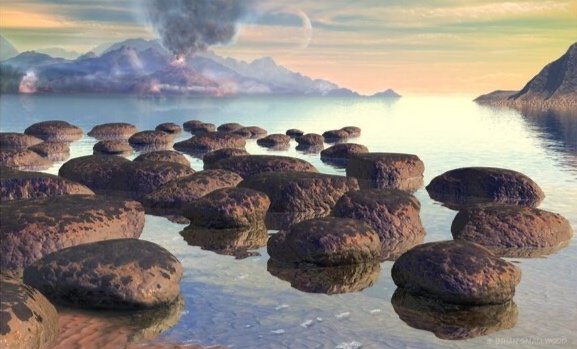From Stromatolites to Martian Leopard Spots: Circumstantial Traces and the Reconstruction of Early Life — Extinct

In this network, S (the layered rock structures) is a direct trace of L (early microbe-activity). But C (a particular geochemical signature, like the distribution of REEs) is not directly linked to L. Instead, it indicates M (an ancient shallow marine environment), which in turn makes L more likely to have been the case. In my terminology, C is a circumstantial trace of L– it supports L (our research target) via an intermediate inferential step.
What kind of things qualify as circumstantial traces? I think two conditions must be met:
-
Causal: the trace shares a common cause with the target event in the past.
-
Epistemic: the trace supports an inference to the target event via an intermediate inferential step.
Both conditions together avoid letting in too much: not every contemporary remnant linked by a distant, and perhaps unknown, common cause is useful. It must also be made epistemically relevant to the target under investigation.
The distinction between direct and circumstantial traces offers a way to conceptualize how different types of traces function in practice, or so I suggest. Circumstantial traces can support or challenge hypotheses about the past. In the Strelley Pool Formation case, they supported the view that ancient microbes cause the formation of the observed stromatolites. Alongside analyzing the rock structures themselves, researchers studied the site’s paleoenvironment, including its geochemical signature. These are direct traces of an ancient marine setting (M), but function as circumstantial traces of microbial activity. In this case, both direct traces (S) and circumstantial traces (C) aligned – they pointed to the same conclusion. If direct and circumstantial traces align, they are both positively relevant for the historical research target in question, even though only one of them is directly causally downstream from the research target.
But such alignment isn’t automatic; it must be carefully established in the course of an investigation. In the above network, connecting C to M, and M to L, requires substantial background knowledge. For the Strelley Pool Formation investigation, considering the environmental setting of contemporary stromatolite-forming microbes was important to foster these links, for instance.
In the case of the putative Greenland stromatolites, this kind of alignment is much less clear. The team of researchers supporting the stromatolite-interpretation cites geological evidence obtained in the surrounding area as evidence suggesting an ancient marine environment – so they invoke circumstantial traces in my terminology. But critics question whether these traces do evidence an environment supporting early microbial life, arguing that the field evidence can be explained without invoking biology. In this case, circumstantial traces don’t clearly support the presence of early microbes. They may even undercut it. To invoke the comparison to the legal case again, imagine an investigation in which the prosecution fails to establish opportunity. Perhaps the defense produced a witness willing to testify that they saw the defendant elsewhere. In a related way, stromatolite-forming microorganisms are less likely to have been active in past if they did not have the opportunity either.
Conclusion
You may have noticed that I started this post talking about possible life traces on Mars, only to spend most of the text discussing cases from Earth. While that ‘detour’ was mostly self-serving (my forthcoming paper is about stromatolites), it was not completely without intention. In fact, what I have proposed to call circumstantial traces may be even more important beyond Earth, where we lack familiar analogues in the form of known life forms and access to relevant sites is severely restricted and indirect. That makes it even harder to identify direct traces with confidence. Lessons from Earth, drawn from cases like the stromatolite investigations, may give examples of what the epistemic contribution of different types of traces is, and the conditions required from them to support hypotheses about the presence of life. How exactly these lessons apply to Mars – especially the putative life traces at Cheyava Falls – remains to be seen. After all, that investigation is really just beginning.
References
Allwood, A. C. 2016. Evidence of Life in Earth’s Oldest Rocks. Nature 537 (7621): 500–501. https://doi.org/10.1038/nature19429.
Allwood, A. C., J. P. Grotzinger, A. H. Knoll, I. W. Burch, M. S. Anderson, M. L. Coleman, and I. Kanik. 2009. Controls on Development and Diversity of Early Archean Stromatolites. Proceedings of the National Academy of Sciences of the United States of America 106 (24): 9548–55. https://doi.org/10.1073/pnas.0903323106.
Allwood, A. C., M. T. Rosing, D. T. Flannery, J. A. Hurowitz, and C. M. Heirwegh. 2018. Reassessing Evidence of Life in 3,700-Million-Year-Old Rocks of Greenland. Nature 563 (7730): 241–44. https://doi.org/10.1038/S41586-018-0610-4.
Allwood, A. C., M. R. Walter, I. W. Burch, and B. S. Kamber. 2007. 3.43 Billion-Year-Old Stromatolite Reef from the Pilbara Craton of Western Australia: Ecosystem-Scale Insights to Early Life on Earth. Precambrian Research 158 (3–4): 198–227. https://doi.org/10.1016/j.precamres.2007.04.013.
Allwood, A. C., M. R. Walter, Balz S. Kamber, C. P. Marshall, and I. W. Burch. 2006. Stromatolite Reef from the Early Archaean Era of Australia. Nature 2006 441:7094 441 (7094): 714–18. https://doi.org/10.1038/nature04764.
Awramik, S. M., and K. Grey. 2005. Stromatolites: Biogenicity, Biosignatures, and Bioconfusion. Proceedings of SPIE – The International Society for Optical Engineering 5906 (September):1–9. https://doi.org/10.1117/12.625556.
Brasier, M., J. Antcliffe, M. Saunders, and D. Wacey. 2015. Changing the Picture of Earth’s Earliest Fossils (3.5-1.9 Ga) with New Approaches and New Discoveries. Proceedings of the National Academy of Sciences of the United States of America 112 (16): 4859–64. https://doi.org/10.1073/pnas.1405338111.
Cleland, C. E. 2002. Methodological and Epistemic Differences between Historical Science and Experimental Science. Philosophy of Science 69 (3): 447–51. https://doi.org/10.1086/342455.
Cockell, C. S. 2015. Astrobiology: Understanding Life in the Universe. Wiley Blackwell.
Criado-Reyes, J., F. Otálora, À. Canals, Cristóbal Verdugo-Escamilla, and J. Manuel García-Ruiz. 2023. Mechanisms Shaping the Gypsum Stromatolite-like Structures in the Salar de Llamara (Atacama Desert, Chile). Scientific Reports 13 (678): 1–10. https://doi.org/10.1038/s41598-023-27666-5.
Currie, A. M. 2018. Rock, Bone, and Ruin: An Optimist’s Guide to the Historical Sciences. MIT Press.
Fenton, N., M. Neil, and D. A. Lagnado. 2013. A General Structure for Legal Arguments About Evidence Using Bayesian Networks. Cognitive Science 37 (1): 61–102. https://doi.org/10.1111/cogs.12004.
Hofmann, H. J. 2000. Archean Stromatolites as Microbial Archives. In Microbial Sediments, edited by R.E. Riding and S.M. Awranik, 315–27. Springer. https://doi.org/10.1007/978-3-662-04036-2_34.
Hurowitz, Joel A., Michael M. Tice, Abigail C. Allwood, Morgan L. Cable, Kevin P Hand, A. E. Murphy, K. Uckert, et al. 2025. The detection of a potential biosignature by the Perseverance Rover on Mars. In 56th Lunar and Planetary Science Conference, 2581. The Woodlands (Texas), United States: Lunar and Planetary Institute. https://hal.science/hal-04930754.
Javaux, E J. 2019. Challenges in Evidencing the Earliest Traces of Life. Nature 572 (7770): 451–60. https://doi.org/10.1038/s41586-019-1436-4.
Kaufman, M. 2019. On the Ground in Greenland: Astrobiology Program-Supported Researchers Travel to a Site of Disputed Evidence of Ancient Stromatolites. Astrobiology at NASA. 2019. https://astrobiology.nasa.gov/news/on-the-ground-in-greenland/.
Kranendonk, M. J. van, G. E. Webb, and B. S. Kamber. 2003. Geological and Trace Element Evidence for a Marine Sedimentary Environment of Deposition and Biogenicity of 3.45 Ga Stromatolitic Carbonates in the Pilbara Craton, and Support for a Reducing Archaean Ocean. Geobiology 1 (2): 91–108. https://doi.org/10.1046/j.1472-4669.2003.00014.x.
Lagnado, D. A. 2011. Thinking about Evidence. In Evidence, Inference and Enquiry, edited by Philip Dawid, William Twining, and Mimi Vasilaki, 183–223. Oxford University Press. https://doi.org/10.5871/BACAD/9780197264843.003.0007.
Lowe, D. R. 1980. Stromatolites 3,400-Myr Old from the Archean of Western Australia. Nature 284 (5755): 441–43. https://doi.org/10.1038/284441a0.
Lowe, D. R. 1994. Abiological Origin of Described Stromatolites Older than 3.2 Ga. Geology 22 (5): 387–90. https://doi.org/10.1130/0091-7613(1994)0222.3.co;2.
McLoughlin, N., L. A. Wilson, and M. D. Brasier. 2008. Growth of Synthetic Stromatolites and Wrinkle Structures in the Absence of Microbes – Implications for the Early Fossil Record. Geobiology 6 (2): 95–105. https://doi.org/10.1111/J.1472-4669.2007.00141.X.
Mojzsis, S. J., G. Arrhenius, K.D. McKeegan, T.M. Harrison, A.P. Nutman, and C.R.L. Friend. 1996. Evidence for Life on Earth before 3,800 Million Years Ago. Nature 384.
Nutman, A. P., V. C. Bennett, R. L. Friend, M. J. van Kranendonk, and A. R. Chivas. 2016. Rapid Emergence of Life Shown by Discovery of 3,700-Million-Year-Old Microbial Structures. Nature 537 (7621): 535–38. https://doi.org/10.1038/nature19355.
Schopf, J. W. 2006. Fossil Evidence of Archaean Life. Philosophical Transactions of the Royal Society of London. Series B, Biological Sciences 361 (1470): 869–85. https://doi.org/10.1098/RSTB.2006.1834.
Turner, D. 2007. Making Prehistory: Historical Science and the Scientific Realism Debate. Cambridge University Press.
Wacey, D., N. Noffke, M. Saunders, P. Guagliardo, and D. M. Pyle. 2018. Volcanogenic Pseudo-Fossils from the ∼3.48 Ga Dresser Formation, Pilbara, Western Australia. Astrobiology 18 (5): 539. https://doi.org/10.1089/AST.2017.1734.
Zawaski, M. J., N. M. Kelly, O. Felipe Orlandini, C. I. O. Nichols, A. C. Allwood, and S. J. Mojzsis. 2020. Reappraisal of Purported ca. 3.7 Ga Stromatolites from the Isua Supracrustal Belt (West Greenland) from Detailed Chemical and Structural Analysis. Earth and Planetary Science Letters 545 (September):116409. https://doi.org/10.1016/J.EPSL.2020.116409.


